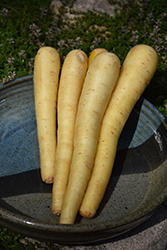Fri & Sat 8am - 8pm
Sun 8am - 7pm
Anytown, USA 12345
fax: 261.787.0463
e-mail: info@successgc.com


Plant Finder

White Satin Carrot
Daucus carota var. sativus 'White Satin'
Height: 18 inches
Spacing: 2 inches
Sunlight:
![]()
Hardiness Zone: (annual)
Description:
A perfect danvers type, great for any garden; produces 10" long ivory white carrots; well rounded, sweet flavor with a crisp texture, perfect for snacking, salads, roasting and any gourmet dish
Edible Qualities
White Satin Carrot is an annual vegetable plant that is typically grown for its edible qualities. It produces large creamy white long roots with creamy white flesh which are harvested from mid summer to mid fall. The roots have a sweet taste and a crisp texture.
The roots are most often used in the following ways:
- Fresh Eating
- Eating When Cooked/Prepared
- Cooking
- Baking
- Freezing
Planting & Growing
White Satin Carrot will grow to be about 18 inches tall at maturity, with a spread of 8 inches. When planted in rows, individual plants should be spaced approximately 2 inches apart. This vegetable plant is an annual, which means that it will grow for one season in your garden and then die after producing a crop. Because of its relatively short time to maturity, it lends itself to a series of successive plantings each staggered by a week or two; this will prolong the effective harvest period.
This plant is typically grown in a designated vegetable garden. It should only be grown in full sunlight. It does best in average to evenly moist conditions, but will not tolerate standing water. It is not particular as to soil type or pH. It is somewhat tolerant of urban pollution. This is a selected variety of a species not originally from North America.; however, as a cultivated variety, be aware that it may be subject to certain restrictions or prohibitions on propagation.
